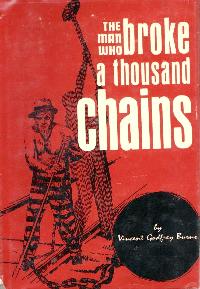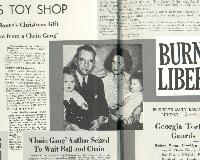
Would harrow up thy soul, freeze thy young blood,
Make thy eyes, like stars, start from their spheres...
Hamlet: Wm. Shakespeare
 - notice the word "GEORGIA" was removed from the title ... click for a bigger image |
In Robert Elliott Burns' book, "I Am A Fugitive From A Georgia Chain Gang", Burns tells the story of his experiences: World War 1, the crime, arrest and conviction, the chain gang and first escape, his years in Chicago, his betrayal and re-arrest, the return to the chain gang and his second escape. The book was written after his second escape (1930) and first appeared in serialized form. The book is considered the greatest epic in American prison history. However, this book does not tell the complete story of Burns' life from 1917 to 1931. The full story of Robert Elliott Burns' life (from birth to death) is told in the book written by his brother, Vincent Godfrey Burns. This book is titled THE MAN WHO BROKE 1,000 CHAINS and was published in 1968. The TV-movie, THE MAN WHO BROKE 1,000 CHAINS (1987), starring Val Kilmer as Robert Elliott Burns is based on an edited version of Vincent Burns' book with modifications of certain events and characters.
The movie opens with scenes of Robert Elliott Burns experiencing the horrors of WW1. In Vincent's book, we discover more about Elliott's life during this time period: he was twenty-five when he enlisted in the Spring of 1917 and had been a successful businessman; he was a Corporal in the Medical Corps and his duty was largely attending the wounded and burying the dead; and by war's end, his nerves had gone haywire.
Next, the movie cuts to a scene of Elliott wearing a wooden placard around his neck that bears the legend: "I fought for you and now you have no place for me." A journey of sound and fury from the horrors of the WW1 soldier to the horrors of the WW1 veteran who returned to no job and no benefits-promises broken by his country. Elliott is promptly arrested by the police. In Vincent's book, the reader learns that after his arrest Elliott's picture was in every paper accompanied by the headline: "Doughboy in Jail!-The Soldier Who Couldn't Get A Job."
 ... click for a bigger image |
Harrowing is the only word to describe the scenes in the movie depicting Elliott's life as a prisoner on the chain gang in Fulton County Camp #9. However, Elliott only spent a few weeks at the Fulton County chain gang camp. It is explained in Vincent's book that Elliott had been shattered in mind and body by the war when he was incarcerated on the chain gang and that his physical and mental condition grew rapidly worse as a result of the back-breaking labor, the wretched food and the brutal lashings. So, Elliott soon realized that it would be impossible for him to do his six years under such conditions and that there were only two alternatives left to him-escape or die! To escape from prison was an act that was part of Elliott's heritage. According to Vincent's book, Elliott used to listen enraptured as their grandfather related tales of his own colorful experiences in the Civil War including his two incarcerations and two escapes from Southern prisons. Moreover, Elliott also realized that on the Fulton County chain gang he'd have great difficulty escaping because the convicts were chained by an additional squad chain while working the roads. Therefore, Elliott wrote to the Prison Commission and asked for a transfer and a few weeks later he was sent to the Campbell County chain gang! Here, conditions were similar to those in Fulton County except for use of the squad chain and the fact that the men slept in pie-wagons (steel-barred wagons on wheels) looking like circus cages but furnished inside with tiers of bunks. Four months later on June 21st, 1922 Elliott escaped.

In THE MAN WHO BROKE 1,000 CHAINS (1987),
Vincent visits his younger brother
Elliott at the prison camp.
Next, the screen fills with photographs of 1923 Chicago where Elliott has been working as a dishwasher and meets Emily del Pino Pacheo (Sonia Braga), a widow who runs a boarding house and who soon gives him a loan to start a magazine. However, Vincent's book states that Elliott's first job in Chicago was in the famous stockyards but that he soon secured a better job as an accountant for a lumber company and that he saved every dollar he earned. When Elliott had saved a little money, he entered the real-estate business and was successful in renting apartments. He acquired a bank account and used this money to establish "The Greater Chicago Magazine" in 1924. Both the movie and the book establish that Elliott was blackmailed into marrying Emily due to his fear of exposure and returning to the chain gang. In the movie, Emily discovers the manuscript that Elliott has been engaged in typing at night; in the book, Emily opened a letter from Elliott's father in which Elliott's Georgia chain gang experiences were mentioned. This is a significant modification made by the movie since the idea of writing a book had not occurred to Elliott (or Vincent either) until after Elliott's second escape in 1930.
And what of Lillian Salo? In the movie, Lillian (Kyra Sedgwick) is a waitress;in the book, Lillian is a taxi-dancer. (Interestingly, in Robert Elliott Burns' own book, "I Am A Fugitive From A Georgia Chain Gang", he meets Lillian in a dance hall but describes her as "a music student, with a desire to become a great violinist" who worked in a restaurant but studied music at night. He also wrote that he arranged for her violin lessons). In both books and in the movie, Emily does betray Elliott when he wants to divorce her in order to marry Lillian. In the movie, after Elliott's second escape from the chain gang (incarcerated May 1929-escaped Sept.1930), he arrives at Lillian's house and discovers that she has married. In the book, after his second escape, Elliott is working in a soliciting job on the staff of a Newark, N.J. newspaper when he phones Lillian who is still in Chicago and asks her to join him. Lillian tells him that she's been out of work for a long time and needs money...so, he wires her the money, goes down to the station to meet her at the appointed time but she fails to arrive. It seemed, so she said, that she needed the money to pay her landlady and some other debts. So, Elliott sends her more money-but, she fails to arrive again. Then in the Spring of 1932, when Elliott is on his way to Hollywood to serve as an advisor at Warner Brothers for the making of the film "I Am A Fugitive From A Chain Gang", he stops off in Chicago to find Lillian. Elliott discovers that Lillian is living in Kenilworth, has married a rich man, and she is fearful and scornful of him as she tells him to go away. It is not the bittersweet farewell as depicted in the movie.
 ... click for a bigger image |
 Near the end of the movie, Elliott is shown in the balcony of the Warner Grand Theater watching the film starring Paul Muni. However, Vincent's book states that Elliott attended a showing of the Muni film at the Branford Theater in Newark on November 15th, 1932 accompanied by a his sweetheart Bertha Wagner. Elliott also attended further showings of the film and frequently got up onstage and spoke to the audience afterwards.
Near the end of the movie, Elliott is shown in the balcony of the Warner Grand Theater watching the film starring Paul Muni. However, Vincent's book states that Elliott attended a showing of the Muni film at the Branford Theater in Newark on November 15th, 1932 accompanied by a his sweetheart Bertha Wagner. Elliott also attended further showings of the film and frequently got up onstage and spoke to the audience afterwards.The TV-movie ends with scenes showing the empty Fulton County Camp and in a written epilogue scrolled onto a scene of broken chains, the film states that after "an enormous struggle" Elliott was finally pardoned on November 1st, 1944. But, what happened to Robert Elliott Burns between the premiere of the Muni film and his pardon in November 1944? The movie does not tell us-it ends its 'storytelling' at the same place where the Muni film ended fifty-five years previously except for the written epilogue. Yet, Vincent Burns' book does tell and the TV-movie is supposed to be based on his book. Elliott was arrested again in Newark on December 14th, 1932 but the Governor of New Jersey eventually refused to allow extradition to Georgia. During this seesaw period between the law in New Jersey versus the law in Georgia, there was a great rallying of support and petitions for Elliott from the public.
Unfortunately, there were also former prisoners and nefarious types who had been paid to plant lies in newspaper stories about Elliott. Elliott was accused of being the mastermind of a burglary ring, a forger, an embezzler and of lying about conditions in the Georgia chain gangs. Emily came forward and swore out an affidavit accusing Elliott of being a bigamist insisting that he had married another woman under an assumed name before marrying her! Additionally, Emily swore that she hadn't been responsible for turning him over to the Georgia authorities. These stories attempted to establish that Elliott was a confirmed law-breaker and criminal in order to get New Jersey to extradite him.
On Dec. 29th, 1932 after a trial, extradition of Elliott was refused by New Jersey. Elliott was a free man in New Jersey-but could still be arrested as a criminal and fugitive in any of the other 47 states of the USA. From 1933 to 1941, there were eight years of success and progress for Robert Elliott Burns. He had established himself as a tax consultant in Newark. He was happily married - not to Bertha Wagner with whom he'd broken up - but to Clara from Scranton,Pa. Elliott had bought a comfortable home in Union, N. J. and had two children at this time. In 1943, a liberal, humanitarian man, Ellis Arnall, became governor of Georgia. The editor of "True Detective Mysteries Magazine" approached Governor Arnall about the "Burns Case." On December 2nd, 1943, Elliott met with the Governor in New York City and stressed that he wanted to remove the stigma of being a fugitive for the sake of his wife and children. The Governor also wanted to remove the stigma on Georgia of being a backwards and inhumane place and to restore the state's former good name. Governor Arnall made an appeal to the Georgia Pardons Board in December 1943. On October 31st, 1944, Elliott went to Atlanta for the appeal hearing and on November 1st, 1944 he was granted a pardon. The fugitive, no longer a fugitive, was at last free...after 22 years!!
On February 22nd, 1955, Elliott was taken to the Veterans Hospital in New Jersey - he had cancer. He battled bravely but on June 10th, 1955, he died and was buried a few days later in the Veterans Cemetery in Burlington, N.J. Robert Elliott Burns was survived by his wife Clara and four children. (He was also survived by his brother Vincent Godfrey Burns, who not only authored "The Man Who Broke 1,000 Chains" but also works of fiction and volumes of poetry and was the poet laureate of the State of Maryland).
A few years before his death, Elliott's wife, Clara, had induced him to join the Catholic Church. If you ever go to Union, N.J., take time to visit its Roman Catholic Church-the steeple was a gift from Elliott. THE END